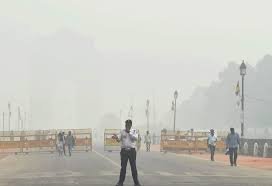
Delhi’s air quality continued to hover in the “poor” category for the second consecutive day on Monday, prompting the Commission for Air Quality Management (CAQM) to enforce Stage-I measures of the Graded Response Action Plan (GRAP). This decision was made after an emergency meeting, as the city’s air quality index (AQI) worsened from Sunday’s 224 to 234 by 4 p.m. on Monday, according to data from the Central Pollution Control Board (CPCB).
Experts have attributed this dip in air quality to calm winds, low temperatures, and local sources of pollution, with the city’s meteorological conditions expected to keep the AQI in the “poor” range over the coming days.
The measures under Stage-I of GRAP will be implemented starting 8 a.m. Tuesday. These include shutting down construction and demolition activities at sites larger than 500 sqm that aren’t registered with the state government, deploying traffic police at congestion-prone areas, and restricting the use of diesel generators for regular power supply. Other measures include periodic mechanized street sweeping and water sprinkling on roads to control dust.
Monday marked the first “poor” air day after the withdrawal of the monsoon, signaling the start of Delhi’s seasonal transition to winter, a time when farm fires, local emissions, and meteorological conditions create a toxic combination in the city’s air.
The AQI exceeded the 200-mark after the Dussehra effigy burnings on Sunday, which saw an AQI of 155 (moderate). On Monday, the situation worsened, pushing Delhi deeper into the “poor” category. “We are seeing dust being raised during the day, but as temperatures dip and winds calm at night, pollutants start to accumulate,” said Mahesh Palawat, vice president at Skymet.
According to the CAQM, the air quality in the region has shown a noticeable dip in the last 24 hours, and the Indian Meteorological Department (IMD) forecasts suggest that the AQI is likely to stay in the “poor” category for the foreseeable future.
Interestingly, stubble burning, often blamed for Delhi’s winter pollution, contributed only 0.6% to the total pollution on Monday, according to the Centre’s Decision Support System (DSS). Instead, Delhi’s transport sector accounted for 18.8% of the total emissions.
Citizens across the National Capital Region (NCR) have been urged to follow measures in the Stage-I “citizen charter” of GRAP. These include keeping vehicle engines properly tuned, maintaining correct tire pressure, ensuring pollution under control (PUC) certificates are up to date, avoiding idling at red lights, and opting for hybrid or electric vehicles to help curb pollution levels.
Delhi’s temperature on Monday was recorded at 18.6°C, a degree below normal, while the maximum temperature stood at 34.4°C. The forecast suggests the maximum temperature will hover around 35°C on Tuesday, with the minimum staying around 18°C.
Sources By Agencies

